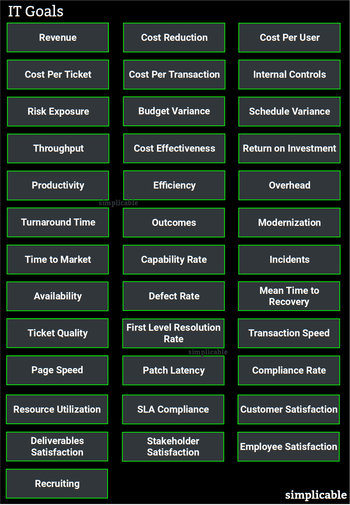
Achieve standards compliance. | Address application / system usability issues. |
Address business pain points with systems, processes and applications. | Address data quality issues. |
Address gaps in IT capabilities e.g. systems that aren't properly backed up. | Address information security risks. |
Address the root cause of an IT problem / recurring incidents. | Automate business processes to improve revenue or reduce cost. |
Automating devops. | Automating incident detection and response e.g. automatically determining what systems are impacted by a hardware failure. |
Automating testing. | Comply with current / upcoming regulations. |
Create self-service interfaces for IT services. | Creating audit trails and increased monitoring of business processes. |
Eliminate redundant systems and data to reduce cost and risk. | Facilitating new ways of working e.g. remove mobile access to systems |
Facility modernization e.g. more energy efficient data centers. | Faster software development release cycles. |
Identify and manage IT risk. | Implement internal controls e.g. segregation of duties for requesting access to systems. |
Implement new systems. | Implement productivity tools such as workflows for work procedures. |
Improve MTTR for incidents. | Improve identity and access management e.g. two factor authentication. |
Improve the turnaround time for IT support requests. | Improve the turnaround time for change requests. |
Increase capacity & ability to scale. | Increase the availability and reliability of systems. |
Increase the maturity / diligence of project management and delivery practices. | Investing in business continuity / disaster recovery capabilities. |
Manage partners to gain more from these relationships e.g. partner scorecards. | Managing, tracking, securing and maintaining IT assets. |
Modernize legacy applications. | Moving to a more mature software development process e.g. proper version control. |
Outsource infrastructure / data centers to reduce cost. | Perform a gap analysis to identify current vs target capabilities. |
Productizing / commercializing internal systems, services and capabilities. | Rationalize IT processes. |
Rationalize architecture to increase responsiveness to change. | Rationalize business processes. |
Recognize failure - end projects, programs and systems that are failing. | Reduce IT costs by using new platforms / services. |
Reduce IT costs with outsourcing. | Reduce exposure to identified IT risks. |
Reduce project / program risk. | Reducing severe incidents. |
Report new IT metrics to provide the business with greater transparency. | Restructure into cross-functional teams to integrate into business units. |
Standardizing operating systems / platforms / hardware. | Streamline products to reduce license fees. |
Strengthen information security capabilities. | Support organizational change such as restructuring. |
Training staff / increasing internal competencies. | Transition to external cloud services to reduce cost. |
Transition to highly scalable / reusable services. | Transition to open source or low cost products. |




























